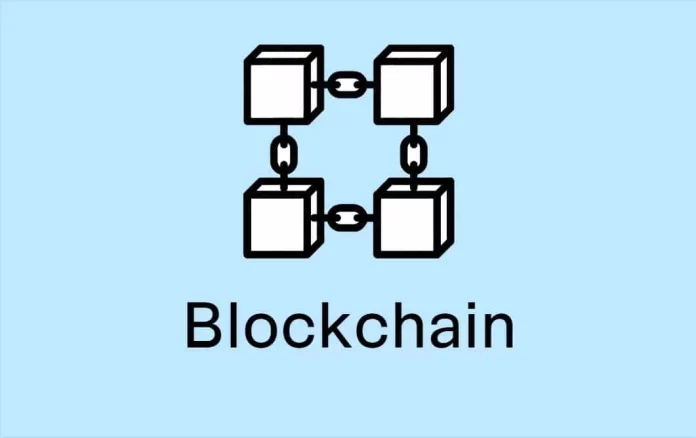
At the present time, Blockchain is a platform that many people are interested in and learn about. With its decentralized nature, Blockchain gradually asserts its position in the technology field, with more and more new applications and features being gradually developed. Many businesses and organizations have been interested in using and exploiting this technology. The following article will help you better understand the characteristics and technology of Blockchain. Read it now.
Origin and development process of Blockchain
Blockchain was proposed to be used in 1990 by Cypherpunk Nick Szabo, but it was not until 1991 that it began to be deployed to help documents become time-invariant, meaning you cannot modify the content and time with any form. A milestone in the development of Blockchain was the birth of Bitcoin in 2008 – the period when the world financial system collapsed, and Satoshi Nakamoto created a new cryptocurrency to create a system—future decentralized transactions based on Blockchain technology.
Blockchain development process
- In 1990, Cypherpunk Nick Szabo proposed using Blockchain to secure a digital payment system called bit gold (never implemented).
- In 1991 Stuart Haber and W. Scott Stornetta introduced a practical solution to timestamping digital documents to make them impervious to forgery.
- In 2004, Hal Finney (Harold Thomas Finney II) developed a system called RPoW, Reusable Proof Of Work 4. The system works by taking an immutable or non-fungible Hashcash 5 to generate an RSA 7 signed 6 tokens for direct exchange from one person to another.
- In 2008, Satoshi Nakamoto conceived the idea of Blockchain, from which this technology began to be developed into applications in several fields.
- 2008-2013 Blockchain 1.0: the arrival of Bitcoin 8.
- 2013-2015: Blockchain 2.0: Development of Ethereum 9.
- 2017: Dapp development blockchain phase.
- 2018: Blockchain 3.0: The Future
- As of 2023, there are around 10,000 active cryptocurrencies on the Blockchain, with hundreds of other non-crypto Blockchains.
What is Blockchain?
Blockchain is likened to a company’s main accounting book (ledger)- where all the company’s money-related activities are monitored closely.
A decentralized network array manages the blockchain, and the input data cannot be changed and shared among the network participants, which makes the data transparent and secure.
Blockchain gradually asserts its own name. It helps to make business operations more accurate, efficient, secure, cheaper, and with fewer middlemen.
Blockchain mechanism of action
The working mechanism of Blockchain is that when new data is inserted into the new Blockchain, that Blockchain will collect information together into groups to store information, linked together over time ( when new data is added to the new block, the new block is chained to the old block).
Data stored in the Blockchain is decentralized, immutable, and very safe, and the data will be shared among network participants. This system ensures high data security against the risk of being stolen.
Uses of Blockchain
Blockchain is used to store information in interconnected blocks of information. It is managed by everyone participating in the system instead of another individual 3rd party like the state or a central bank. It enables secure data transmission using a complex and time-scalable encryption system.
Due to the decentralized operating mechanism, Blockchain can resist data changes in the system and help data to be transmitted without requiring an intermediary to confirm the information.
Consequently, Blockchain is suitable for storing sensitive and important documents such as online bank accounts, payment card accounts, etc. Even if one part of the Blockchain system is hacked, the other parts are not affected and continue to work to protect information.
Structure of Blockchain
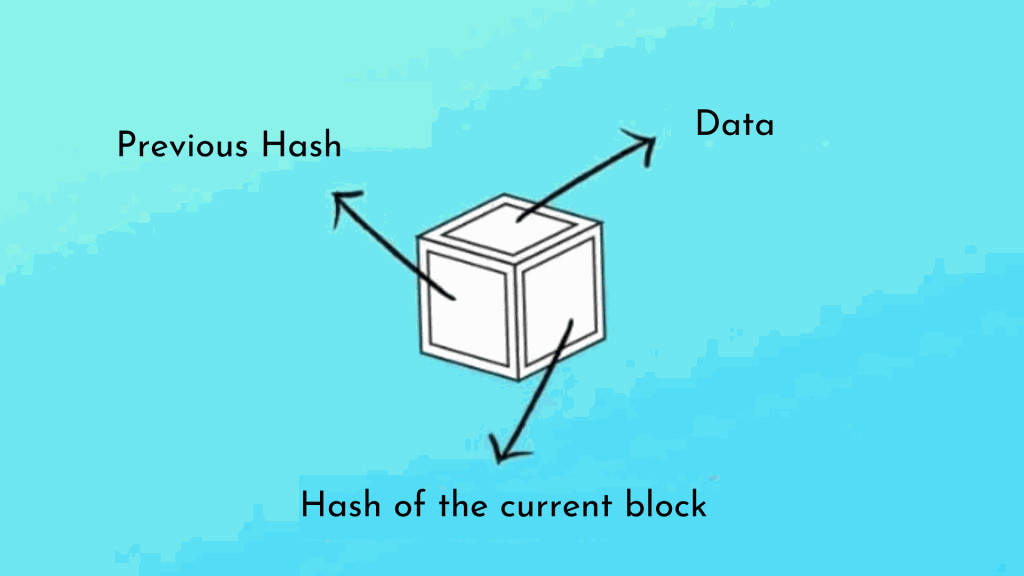
Each block will be stored in 3 parts:
- Data is a record of data that is authenticated through a consensus mechanism and protected by the appropriate encryption algorithm of each Blockchain. The data will depend on the type of Blockchain. For example, Bitcoin’s Blockchain will contain transaction data. Transaction data includes Information about the sender, receiver, and the number of coins sent.
- The previous block, also known as the hash code, is used to identify adjacent and linked blocks’ front and back positions. Thanks to this hash, the linked blocks create a chain. However, the first block will not be associated with any other blocks. Because it was created first.
- The hash of the current block as an identifier. It is unique and does not match our fingerprints.
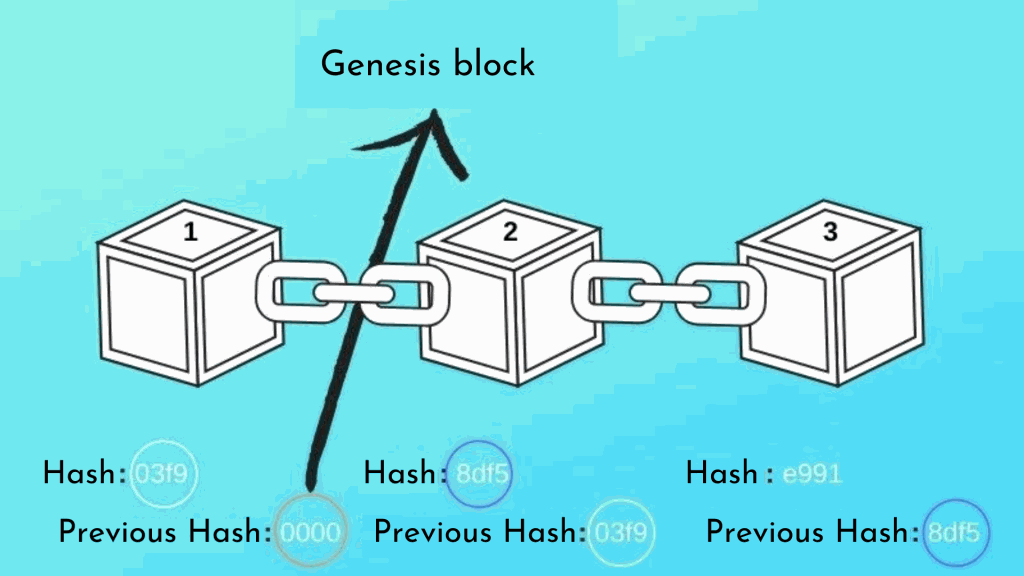
This first block is called Genesis block, which translates into Vietnamese as “Primitive Block”.
Benefits and Limitations of Blockchain
Benefits
- Chain accuracy: approved by many computers-> fewer errors and accurate information storage (error only occurs with one block copy).
- Reduce costs: eliminate the need for verification and 3rd party costs.
- Decentralization: information is stored on all blocks, not in a central location; when a new block is added-> all computers are updated with the change.
- Efficient trading: 24/7 transaction time, completed in as little as 10 minutes and safe in a few hours.
- Private transactions: can view network transactions but cannot view information about users.
- Secure transaction: When a transaction occurs, many computers on the Blockchain will confirm the accuracy, and if correct, will be added to the block; each block has its own hash (when each block is edited, the hash of the block will be changed), that will change but the following block hash remains the same).
- Transparency: Its open-source code is visible to everyone.
- Unbanked banking: allowing unidentified people to use.
Limitations
- Technology costs: Blockchain technologies have fees, for example, Bitcoin mining fees.
- Speed and data inefficiencies: Blockchain projects have speed inefficiencies. For example, bitcoin takes 10p to add a new block (in that time, Blockchain can manage 7 transactions per second), Ethereum performs better but is still limited by Blockchain, and Visa can handle 65,000 TPS.
- Illegal activity: illegal transactions such as money laundering and drug dealing may occur.
- Regulation: the government has strict regulations on cryptocurrencies
Main Features of Blockchain
Blockchain technology acts like a ledger that records all transactions in the system. Blockchain gradually asserts its own name, which helps to make business operations more accurate, efficient, secure, cheaper, and with fewer middlemen. There are 10,000 active cryptocurrencies on the Blockchain, with hundreds of other non-crypto Blockchains.
The main features of Blockchain can be mentioned as follows:
Can’t fake, can’t destroy Blockchain chains
Blockchain chains are nearly indestructible. Theoretically, only quantum computers can interfere with and decipher the Blockchain. It was only completely destroyed when there was no internet left globally.
Invariant
The data in the Blockchain is almost immutable. It can only be modified by the person who created it but must be agreed upon by the network nodes, and the data will be kept forever.

Data security
The information and data in Blockchain chains are distributed and safe. Only the holder of the private key has access to that data.
Anyone can track the path of data in the Blockchain from one address to another and the entire history of that address.
Smart contract
A smart contract is a computer code that can be integrated into the Blockchain for situational execution where transactions can be performed under different conditions. It is considered digitally embedded by an if-this-then-that (IFTTT) code in the system, which allows them to execute on its own without the need for a third party. It ensures that all parties know the contract details and that the terms are automatically implemented once the conditions are met.

The feature that makes Blockchain data impossible
Hash
To modify the data of a block, the Hash of that block will be changed. Blocks after it, the modified block becomes invalid. Because now the previous block’s hash is not the same as the modified block. So the only way to modify a block’s data is to make all the blocks behind it valid.
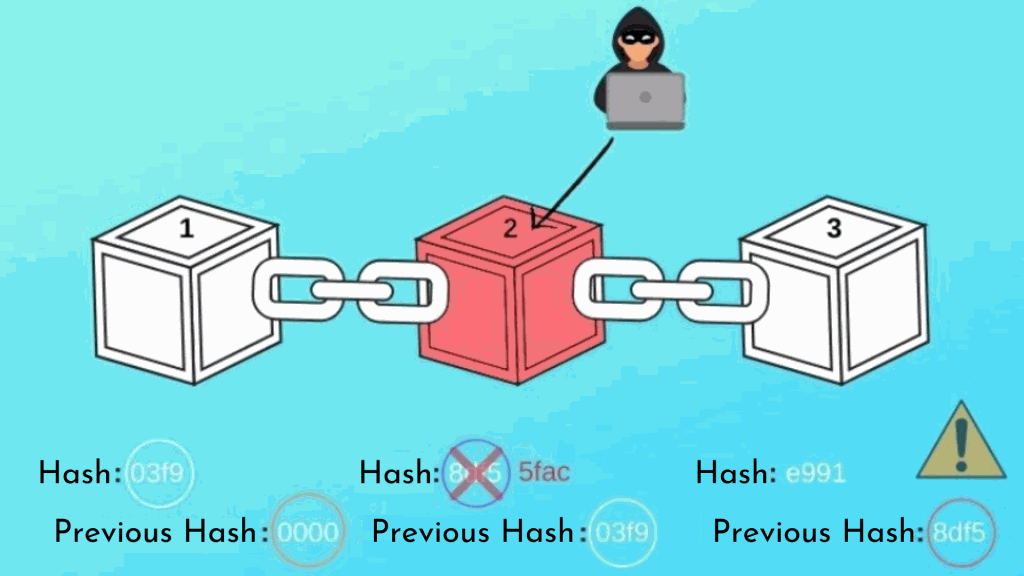
Mechanism
Once everyone in the network is recognized, the transaction is added to the new data block, and the transaction information is stored indestructibly. To make the block valid, you have to tamper with the blocks and change the Hash one at a time. But because the data computer can calculate very fast, every second can calculate hundreds of days Hash so that it will affect the security; this luvs thanks to the consensus mechanism that will decide who adds the new Block, thereby ensuring integrity and security.
Peer-to-Peer Network (P2P Network)
Blockchains use a peer-to-peer network architecture instead of central management.
This means anyone can join the network. Each individual in the network acts as a node, all nodes have equal functions, and no one is the owner, but each person is the master himself, and the nodes are stronger and more secure, better secret. They will receive a full copy of the Blockchain. They use this copy to confirm everything is still in order.
All nodes create consensus. If this consensus exceeds 50%, the block is valid and added to the Blockchain. Peer-to-peer networks combined with consensus form a layer of protection against malicious activity.
Blockchain Classification
The Blockchain system is divided into 3 main types: Public, Private, and Permissioned.
Public Blockchain
This is a Blockchain system where anyone can read and write data on the Blockchain. Users can record and edit data entered into each block. Everyone who has an account has this benefit.
However, validating transactions on this Blockchain requires thousands or even tens of thousands of participating nodes; therefore, this process will take a long time. Therefore, attacking this Blockchain system is impossible because the cost is very high.
Public Blockchain has the characteristics of being decentralized, without the participation of 3rd parties, and the network is quite large, so the government cannot control it.

Public Blockchain examples: Bitcoin, Ethereum…
Private Blockchain
This Blockchain system allows users only to read data, not write, because this belongs to a trusted third party. Only a few devices participate in transaction validation for this type, so the transaction confirmation time is quite fast.
The private Blockchain is centralized, which means that this third party may or may not allow users to read data in some cases. The third party has full authority to decide on any changes on the Blockchain. Therefore, it suits companies wanting to control activities but not publicize information.
For example, Ripple is a form of Private Blockchain; this system allows 20% of nodes to be fraudulent and only needs the remaining 80% to work stably.

Permissioned Blockchain
Also known as Consortium. This is a form of Private Blockchain but adds certain features depending on the 3rd party provider. It combines “belief” when participating in Public and “absolute faith” when participating in Private.
For example, banks or joint venture financial institutions will use Blockchain independently.

Major Versions of Blockchain
Blockchain 1.0
Blockchain 1.0 – Currencies and Payments: An early and early version of Blockchain.
The main application of this release is crypto-related work. It includes currency conversion, remittance, and digital payment system creation. Blockchain 1.0 makes virtual currency transactions more decentralized, transparent, and faster.
This field is familiar to many people; sometimes, many people mistakenly believe that Bitcoin and Blockchain are the same.
Blockchain 2.0
Blockchain 2.0 – Finance and Markets: This is the 2nd version of Blockchain.
This version is an upgraded Smart Contract that is pre-programmed, signed between the parties, and closely monitored. Smart Contract achieves the highest level of security because it is not interfered with by 3rd parties.
Its application is in financial processing and banking: scaling of Blockchain, bringing integrated Blockchain into financial and market applications. Assets include stocks, checks, debit, title, and anything related to an agreement or contract.
Blockchain 3.0
Blockchain 3.0 – Design and Operational Monitoring
This version combines Smart Contract and Dapp – where data is stored in a decentralized data store and written in a programming language.
Blockchain technology will go beyond the borders of only serving the financial sector in this version. It targets other areas such as education, government, health, and arts…
Blockchain 4.0
Blockchain 4.0 – Enterprise
This release is focused on companies and businesses to create and run more efficient, secure, and fast trading applications.
Companies/enterprises can control what data the account can view while ensuring security and preventing the modification of information during the transaction process.
Consensus mechanism of Blockchain
The consensus mechanism in Blockchain can be understood as how every administrator in the Blockchain system can agree for a transaction to occur in the system. Here are the common types of consensus mechanisms in the Blockchain.
Proof of Work
Proof of Work (PoW) is the most popular consensus mechanism used in Bitcoin, Ethereum, Litecoin, Dogecoin, and most cryptocurrencies.
PoW became popular in mining activities. Miners will use PoW to solve Hash generation problems, confirm transactions, and create new blocks if successful. This is a consensus mechanism that consumes a lot of power.

Proof of Stake
Proof of Stake (PoS): This is a popular consensus mechanism in Decred, Peercoin, and in the future, Ethereum and many other cryptocurrencies. This consensus mechanism is more decentralized, consumes less energy, and is not easily threatened.

Delegated Proof-of-Stake
Delegated Proof-of-Stake: This is a common consensus mechanism in Steemit, EOS, and BitShares. For this mechanism, token holders will choose several professional nodes to represent them to operate the network, and token holders who maintain the network’s security will share a portion of the reward.
This mechanism helps to secure the network of the coin. This consensus mechanism has low transaction costs, extendable, and high energy efficiency. However, it is still somewhat centralized because this algorithm chooses trusted people to authorize.
This mechanism helps to secure the network of the coin. It has low transaction costs, is extendable, high energy efficiency. However, it is still somewhat centralized because this algorithm chooses trusted people to authorize.
Proof of Authority
Proof of Authority (PoA) is a mechanism that upholds the value of a participant’s identity and reputation. This is a common consensus mechanism commonly found in POA.Network, Ethereum Kovan testnet.
PoA has limited validators, blocks, and transactions moderated by more trusted validators. So this consensus mechanism has high performance and good scalability.
Proof-of-Weight
Proof-of-Weight is an Algorand-based consensus algorithm with a working mode similar to PoS; this mechanism is based on the number of tokens held in the network, which will be equivalent to the percentage of probability that the next block will be generated. It is commonly used in Algorand, Filecoin.
This consensus mechanism is customizable and well-extensible, so it is energy efficient, customizable, and highly scalable. However, the process of accelerating development will be a big challenge.
Proof of Reputation
Proof of Reputation is quite similar to Proof of Authority; it works on the reputation of the participating parties to keep the network safe. A party participating in validating the block must be reputable enough, and their reputation will be affected if they deliberately cheat. This mechanism is used in GoChain
Byzantine Fault Tolerance
Byzantine Fault Tolerance (BFT): This is a popular consensus mechanism in Hyperledger, Stellar, Dispatch, and Ripple. This is a mechanism to solve the problems of the Byzantine problem; that is, the BFT system can continue to work even if some nodes fail or take actions that harm the general network.
This consensus mechanism is highly productive, low-cost, and scalable. However, it is still not completely reliable.
This algorithm has 2 versions:
- Practical Byzantine Fault Tolerance (Anti-Fraud Consensus / Byzantine Generals Encircle Blockchain in Reality)
- Federated Byzantine Agreement (Byzantine Union by consensus)
Directed Acyclic Graphs (DAG): This is a consensus mechanism commonly found in Iota (Tangle technology), Hashgraph, and Raiblocks/Nano (Block-lattice technology), which is a Blockchain competitor. DAG stores data in the form of directed ac graphs; this structure is highly efficient in data storage.
Apply Blockchain in Life
Apply Blockchain in industry and services
Enterprises apply Blockchain in their services
Business Services
Blockchain brings many great benefits to businesses and makes business operations easier. Helping businesses gain the trust of users and save more costs.
Microsoft and ConsenSys are working together to deliver Ethereum Blockchain as a Service (EBaaS) on Microsoft Azure so that Enterprise customers and developers can have a Blockchain development environment.

Google is also working on a proprietary Blockchain to support the business. Parent company Alphabet is developing a distributed ledger that third parties can use to store data, allegedly related to Google’s cloud services for businesses.
Energy industry
In Fremantle and Australia, a project on energy and water systems using Blockchain technology has been built. Solar panels are being used in a sunny area to collect electricity, which is then used to heat water and provide power, and the data is recorded on the Blockchain.
Chile’s National Energy Board has begun using Blockchain technology to validate data on energy use. The South American nation’s electrical infrastructure will be modernized and more secure by storing sensitive data on Blockchain.
Apply Blockchain in the agriculture and seafood industry
Fishing
Fishing is increasingly being exploited, and trillions of dollars are spent annually on coastal resource exploitation activities. However, illegal fishing is threatening the development of this industry. Blockchain is currently being used to support sustainable fishing.
Distributed ledger technology provides a means to prove where fish was caught, processed, and sold. This “net-to-plate” chain allows inspectors to determine whether fish are from areas notorious for human rights abuses or countries affected by economic sanctions.
Agriculture
Food quality affects us a lot to our body poor quality products can be the source of chronic diseases such as heart, cancer, and stroke,…
Did you know food, pants, etc., where did your shirt… come from? Supply chain management is extremely complex and often involves dozens of intermediaries from production to purchasing.
- Food industry: A Blockchain application that can improve transparency and efficiency in discovering what foods may be contaminated and where throughout the supply chain.
- OriginTrail: This Blockchain platform lets consumers know where the food goods they buy come from and how they are produced.

So how can we ensure product quality, transparency, and reliability on a long journey from producer to consumer? The correct answer is Blockchain.
Apply Blockchain in construction.
Real Estate
The phenomenon of impersonating landowners is gradually spreading everywhere; many people have been suffering from buying fake real estate through unscrupulous 3rd parties. Real estate transactions need to be more transparent and secure. Blockchain will make this easier with benefits: creating a reputable platform and market, reducing intermediaries, increasing liquidity, transparency, and reducing costs.
Ukraine is honored to be the first country to use Blockchain to facilitate a property agreement. Prominent crypto advocate and TechCrunch founder Michael Arrington have sold the property.
This deal is enabled with the support of smart contracts on the Ethereum Blockchain and is intended to be the first of many completed by Propy, a startup specializing in real estate transactions Blockchain-based.
Rail
Railway operator Novotrans in Russia is using Blockchain technology to improve the speed of its operations. They will use Blockchain to record data regarding repair requests, inventory, and other issues related to their operations. Blockchain records help prevent tampering and data corruption.
Land use rights
Blockchain is widely applied in the real estate sector, developing in many countries and attracting many investors.
The Georgia government uses it to register land titles. They created a custom-designed Blockchain system and integrated it into the digital records system of the National Public Registry (NAPR). Georgia is currently taking advantage of the transparency and fraud reduction offered by Blockchain technology.
Apply Blockchain in waste management activities.
Waltonchain’s RFID technology is used by the Smart Waste Management System in China. Using Walton’s Blockchain, the project will enable waste level monitoring to improve operational efficiency and optimize resources.

Apply Blockchain in the wholesale and retail industry
Many Blockchain projects are developing in the field of mobile payments. Many businesses also have great interest in using Blockchain in mobile payments.
One of the latest initiatives announced, launching in the fall of 2018, will involve a consortium of Japanese banks. They will use Ripple’s technology to enable instant mobile payments.
Supply Chain
Supply chain management is considered one of the most beneficial use cases for Blockchain, making it ideal for industries where goods are passed through many different hands, end-to-end or manufacturer-to-shop.
IBM and Walmart have partnered to launch the Blockchain Food Safety Alliance in China. The project, run in conjunction with Fortune 500 company JD.com, is designed to improve food safety and tracking, making it easy to verify that food is safe to consume.
Apply blockchain in transportation and warehousing.
Shipping
Blockchain‘s suitability for recording shipping data is obvious. Several projects have distributed ledger technology to work in this area. Use it in the maritime logistics industry to bring transparency to the inevitable bureaucracy in international trade.
The two respective industry giants, IBM and Maersk, have come together to create the world’s first shipping Blockchain platform, TradeLens.
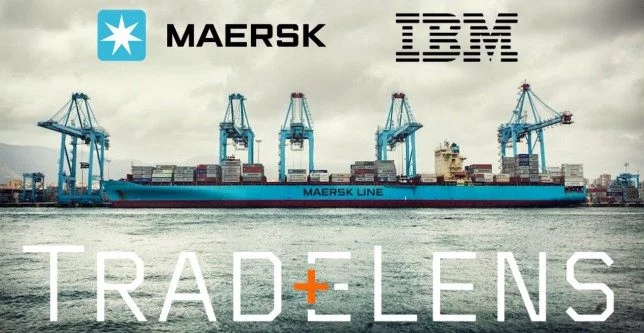
Apply Blockchain in financial activities and banking.
Finance, Banking
Bitcoin Atom
Bitcoin Atom is a new fork that allows easy exchange of cryptocurrencies with no transaction fees; it makes Bitcoin decentralized.
This technology is based on atomic swaps. It is an invaluable cryptocurrency exchange tool and does not require a trusted third party.
But for now, the widespread adoption of atomic swaps has been prevented because they require high technical skills. Bitcoin Atom can only partially solve this problem.
Securrency
Securrency is a trading platform for cryptocurrencies and several types of assets, including non-cashable ones.
All are exchanged through Securrency tokens. The project allows cryptocurrencies to be traded outside of their dedicated exchanges.
Ripple
Apply Blockchain in mining.
Ripple aims to be a global payment solutions provider. They will connect payment service provider banks, businesses, and digital asset transactions. Transactions are settled instantly, according to global demand.
ABRA
ABRA is a global app and crypto wallet that allows you to buy, invest and store 20 cryptocurrencies, including Bitcoin, Ethereum, Litecoin, and more.
Aeternity
Aeternity is a highly scalable Blockchain platform. It can be used for any application that requires high transaction speed.
Includes smart contracts generated from on-chain, nano, and micropayments.
Diamond
De Beers Group – the world-famous diamond company, has its own Blockchain called “Tracr” designed to set a digital record for every diamond registered on the platform.
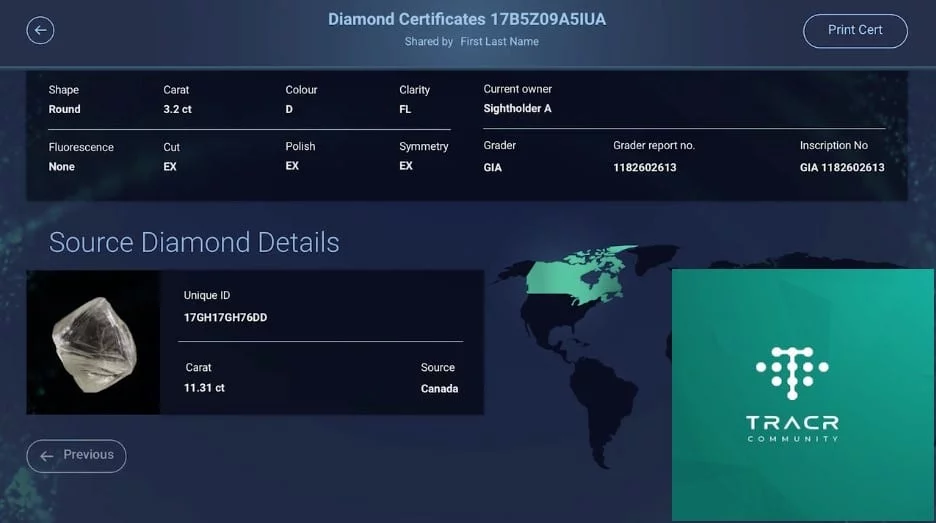
Because of the transparency, security, and safety of Blockchain, the diamonds will be guaranteed of origin and avoid the risk of being exchanged for something of less value.
Oil
Oil companies have gradually applied Blockchain technology to production. S&P Global, one of the leading players in the commodity market, is testing a Blockchain solution used to record oil storage data. Blockchain will store weekly inventory for this company, which will help reduce the need for manual data management, minimizing possible human errors.
Carbon
In March 2017, IBM launched a carbon asset tracking vehicle in China, the Blockchain Food Safety Alliance, in conjunction with the Energy-Blockchain Lab; this creates a measurable and auditable system to track emissions and facilitate a tradable market for companies looking to offset their energy consumption while encouraging green industrial activities.
Energy
Energy companies that are in the habit of storing transactions that provide surplus value need to keep a record, which must be infallible. So, tracking energy allocation in real-time and ensuring efficient distribution through the supply chain requires multiple data points and close cooperation between all entities.
Blockchain projects in use are increasing day by day. From logistics to fine arts, it’s hard to find an area untouched by this transformative technology. Blockchain has proven its superiority at the present time.
Apply Blockchain in Education.
Now, the problem of fake degrees is hidden everywhere. In 2010, the doctoral degree (Ph.D.) of former Microsoft China president Tang Jun received from Pacific Western University raised suspicions.
Investigators found that for as little as $2,595, students would receive a doctorate without any education; these schools were also unaccredited.
A year later, dozens of other senior managers were also embroiled in other large-scale cases of fake degrees from dubious programs.
Enrollees only study “for the sake of law.” Therefore, it is very important to ask for transparency and clarity. Some schools have also applied Blockchain to the management of the learning process. The University of Nicosia is the first school to manage student certificates using Blockchain technology through the MOOC platform. Japanese company Sony has applied Blockchain to create a global assessment platform for student information and educational records.
In addition, many universities in many countries have also begun to bring this new technology into the education system to teach at a universal level.

Intellectual Property
Currently, piracy and infringement of intellectual property rights is a problem that has happened for a long time and occurs frequently in this technological age. Thanks to the transparent and secure nature of Blockchain will probably help solve this problem. Blockchain technology will help protect authors’ copyrights safely, easily, and conveniently against acts of infringement.
Whether you are a musician, writer, painter, etc., you still want to claim the property rights for your works, and you can receive the costs related to the copyright of your work. Blockchain technology can help us protect our assets by confirming the author when the work is posted, giving them control over when the product is used, and preventing possible infringement.

Apply Blockchain in food service.
In food service, Blockchain can help solve origin problems and help with product quality tracking and traceability. Thus, we can prevent food of unknown origin and reduce the costs of product recalls.
Blockchain is also accelerating in the alcohol and beverage industry. In March 2019, news emerged that premium whiskey brand Ailsa Bay would release what it believes to be the world’s first scotch whiskey tracked with a Blockchain-based system.
While later in May, Big Four auditing firm E&Y announced its proprietary Blockchain solution for a major new platform that helps consumers across Asia determine the quality, provenance, and authenticity of imported European wines.
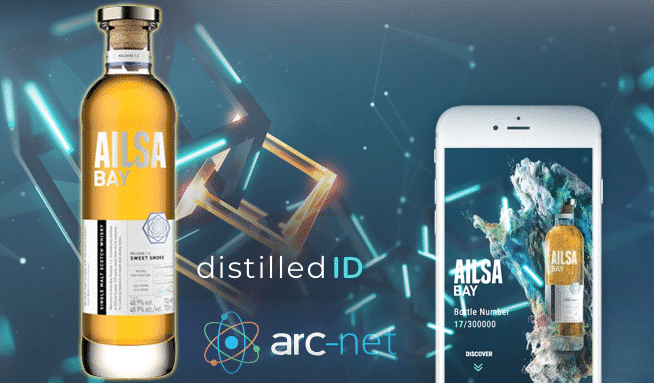
In addition, Blockchain also supports the sale of food and beverage products. Australian company AgriDigital used Blockchain to sell wheat to buyers in 2016, then they used Blockchain for food traceability and supply chain provenance.
Apply Blockchain in information and communication
Advertisement
Blockchain has the power of distributed data, and if you know how to use it in advertising, it will achieve the goal of reaching more potential customers. Blockchain helps prevent fraud in advertising, eliminating fraudulent tricks such as virtual clicks and virtual interactions…
In partnership with Nasdaq, the New York Interactive Advertising Exchange is using Blockchain to create an electronic marketplace where brands, publishers, and agencies can buy ads. The Ethereum Blockchain Open Protocol will make this process as simple and secure as possible.
Newspapers
Readers always want highly accurate information and news, but with fake news rampant on social networks, readers doubt the news they can access. Blockchain technology will be an optimal solution to solve this problem.
Civil is a decentralized journalism marketplace that offers the benefits of Blockchain and an economic incentive model for quality news content, along with the ability to permanently archive content, which will remain accessible to anyone at any time.
Apply Medical and social life activities.
Medical
With the world population increasing, the number of patients is quite large, making it difficult to manage patient records. Blockchain technology will support the storage of medical examination results and related records for easy patient access and management by the hospital. This helps patients keep their personal information secure.
This is also quite convenient for hospital transfers; operations will eliminate and replace complicated traditional procedures to retrieve information and find patient records on the Blockchain.
MedicalChain
MedicalChain is the first healthcare company to use Blockchain technology. It facilitates the storage and use of electronic medical records to provide a complete telemedicine experience.
They are doctors in the British healthcare system and want to change it from within.
MedRec
MedRec provides any healthcare provider with secure access to patient records.
MedRec uses Blockchain to save time, money, and repetitive processes in conducting procedures between different facilities and providers.
Patients can also access their medical records to research medical providers.

Insurance
Insurance fraud is happening more and more, Blockchain will help insurance companies prevent this situation by permanently recording transactions and detailed access measures to protect data security.
Blockchain has gradually been implemented in the insurance industry. In partnership with International Business Machines Corp., insurance company American International Group Inc has completed a pilot of a multinational policy known as smart contracts against Standard Chartered Bank PLCs and plans to govern complex international scope management through Blockchain. ClaimShare – a product of technology startup IntellectEU launched in March 2021, allows insurance companies to share data related to claims.
Health care
Medical records are notoriously rampant and error-prone, and inconsistent data processing means hospitals and clinics are often forced to work with inaccurate or incomplete patient records. Healthcare projects are using Blockchain to support data sharing while providing authentication and maintaining security.
Social life
LGBT community: Blockchain can be useful in building Germany’s rosy economy and helping the LGBT community fight for its rights without revealing people’s identities.
In many countries, homosexuality is prohibited, and do not want LGBT appearances. Therefore, the confidentiality of identity is very important and helps protect human rights in the LGBT community.
Apply Blockchain in state management and national security.
Tax
While Blockchain provides us with transparency and can control our data. Tax evasion is also common in many countries, and Blockchain will help governments control this.
In China, authorities currently use a Blockchain for both taxation and issuing electronic invoices.
The project was launched in 2017. The first Blockchain invoice was created in August 2018 at a local restaurant.

Vote
Due to complex security issues and electoral fraud, few countries have switched to electronic voting machines (EVMs).
EVM makes voting more accessible. Thus, promoting people’s participation in elections. However, most countries commented that the risks outweigh the positives.
Blockchain can solve this problem; it provides immediate results, eliminating the dangers of counting votes. The immutability of Blockchain means problems like double voting. Changing votes and deleting votes will be “deleted” overnight.
Blockchain will also eliminate the need to count votes and produce results immediately after polls.

National security
In 2016, the US Department of Homeland Security (DHS) announced a project that would use Blockchain to securely store and transmit the data it acquires. Using the Factom Blockchain, data retrieved from security cameras and other sensors is encrypted and stored. Use Blockchain as a means to minimize the risk of data breaches.
Border control
Currently, passengers on the Eurostar train between the two countries undergo border control at multiple locations. Blockchain will provide a means to ensure that data has not been tampered with and is accurately verifiable.
ID card
The canton of Zug in Switzerland, known as Crypto Valley, the headquarters of a group of Blockchain companies, has developed a Blockchain project in partnership with Uport to register residents’ IDs. It allows them to participate in online voting and prove their residency.
Apply Blockchain in art, play, and entertainment.
Handicraft
Fine Handicrafts have high requirements in determining the origin and authenticity of the works. Blockchain will help work owners prove their work copyright.
In addition, Blockchain is now used as a means of obtaining artwork. It’s another example of how Blockchain technology can make tangible objects easily translatable and exchangeable from anywhere in the world without physical transfer from secure memory.
Music
Blockchain‘s decentralization eliminates intermediaries or middlemen. Usually, artists will be managed by a 3rd party and may be paid less than they spend. Applying Blockchain to music projects will help music creators have a fairer deal.
Example: Inmusik, a music ecosystem using Blockchain. Apply to listeners and musicians to monetize content creation, discovery, and updates.

Gaming
The game attracts the attention of many people willing to spend money to buy in-game items. Many players have a huge treasure trove of high-value items in their accounts.
This creates security issues. What if a hacker steals it? What if the parent company’s server goes offline?
By implementing a Blockchain, gamers will eventually be able to own these items and have complete control over their state.
It will also become easier and safer to transfer in-game items to others. No one can illegally copy them.

Travel
Blockchain has many applications in the tourism sector, such as ensuring secure payments, ID and security, tracking customer assets, etc.
Blockchain is being studied to improve Hawaii’s economy by allowing tourists to pay for local goods and services in Bitcoin and other currencies. In this way, it is hoped to attract tourists, especially from Asia, so that they spend more money and ultimately help Hawaii grow economically.
Some others apply Blockchain.
Protecting rare animals
There are many projects built with non-profit purposes to conserve rare animals worldwide.
“Care for the Uncared” is a non-governmental organization working with leading developers to find ways to conserve and protect endangered species using Blockchain technologies.
A smart city
Smart cities are no longer science fiction. Taipei is trying to position itself as a city of the future with the help of Distributed Ledger Technology. They have partnered with IOTA and are working on creating tokens with light, temperature, humidity, and pollution detection.

Epilogue
In general, Blockchain is growing strongly and attracting a lot of attention from the community. Blockchain is applied in many areas in practice, not only in cryptocurrencies.
The article has summarized the main content of Blockchain. Hopefully, the article will help readers understand Blockchain technology and its potential in various fields.


